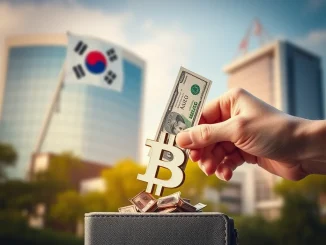
In a surprising move that sent shockwaves through financial markets, the Bank of Korea (BOK), South Korea’s central bank, has announced a significant reduction in its base interest rate. The rate has been lowered by 25 basis points, bringing it down from 3.0% to 2.75%. This unexpected decision, revealed on their official website, has sparked widespread discussion about its potential implications for the South Korean economy and beyond. But what does this Korean interest rate cut really mean, and how might it affect you?
Decoding the South Korea Rate Cut: A Closer Look
The Bank of Korea’s decision to implement a South Korea rate cut comes at a time of global economic uncertainty. Central banks worldwide are grappling with balancing inflation control and economic growth. This rate cut signals a potential shift in focus for the BOK, possibly leaning towards stimulating economic activity. Here’s a breakdown of what we know:
- Rate Reduction: The base rate is now at 2.75%, a 0.25% decrease from the previous 3.0%.
- Official Announcement: The information is directly from the Bank of Korea’s official website, ensuring its authenticity.
- Surprise Element: Many analysts were not expecting a rate cut at this juncture, making the announcement somewhat unexpected.
This move places South Korea in a unique position compared to some other major economies that are still aggressively fighting inflation with rate hikes. It raises important questions about the BOK’s assessment of the current economic landscape and its future outlook.
Why Did the Bank of Korea Opt for a Base Rate Cut?
To truly understand the significance of this base rate cut, it’s crucial to consider the possible motivations behind the Bank of Korea’s decision. While the official statement will provide detailed reasoning, we can infer some likely factors:
- Slowing Economic Growth: South Korea, like many nations, might be experiencing signs of economic slowdown. A rate cut can act as a stimulus, encouraging borrowing and investment to boost economic activity.
- Inflationary Pressures Easing: If the Bank of Korea believes that inflationary pressures are beginning to subside, or are under control, they might feel comfortable easing monetary policy to support growth.
- Global Economic Headwinds: The uncertain global economic outlook, including potential recessions in major economies, could be prompting the BOK to take preemptive measures to safeguard the domestic economy.
- Supporting Domestic Demand: Lower interest rates can make borrowing cheaper for businesses and consumers, potentially increasing spending and investment within South Korea.
It’s important to note that central bank decisions are complex and data-driven. The BOK would have considered a wide range of economic indicators before arriving at this decision. Further statements and press conferences from the Bank of Korea will likely provide more detailed insights into their rationale.
The Broader Economic Impact of the Interest Rate Adjustment
The economic impact of this interest rate cut is multifaceted and will ripple through various sectors of the South Korean economy. Here’s a look at some potential consequences:
| Area of Impact | Potential Effect |
|---|---|
| Borrowing Costs | Lower interest rates mean cheaper loans for businesses and individuals, potentially stimulating investment and consumption. |
| Consumer Spending | Reduced borrowing costs for mortgages, car loans, and personal loans could encourage consumers to spend more. |
| Business Investment | Lower rates can make it more attractive for businesses to borrow money for expansion, new projects, and research and development. |
| Currency Value (Korean Won) | Interest rate cuts can sometimes lead to a depreciation of the domestic currency as it becomes less attractive to foreign investors seeking higher returns. |
| Inflation | While intended to stimulate growth, rate cuts can also potentially fuel inflation if demand increases significantly without a corresponding increase in supply. |
It’s a delicate balancing act for the Bank of Korea. They aim to boost economic activity without reigniting inflationary pressures. The effectiveness of this rate cut will depend on various factors, including global economic conditions and domestic consumer and business confidence.
What Does This Mean for Cryptocurrency and Digital Assets?
While a central bank rate cut in South Korea might seem distant from the world of cryptocurrency, it can have indirect but noteworthy implications for digital assets. Here’s how:
- Risk Appetite: Lower interest rates generally increase risk appetite among investors. With traditional fixed-income investments offering lower returns, some investors might look towards higher-yield, albeit riskier, assets like cryptocurrencies.
- Korean Won and Crypto Markets: The potential weakening of the Korean Won due to the rate cut could make cryptocurrencies, particularly those priced against the Won, relatively more attractive to Korean investors as a hedge against currency devaluation.
- Economic Sentiment: A rate cut can be interpreted as a sign of concern about economic growth. In such environments, some investors might seek refuge in alternative assets like Bitcoin, often seen as a store of value.
- Liquidity and Investment Flows: Easier access to credit and lower borrowing costs within South Korea could potentially increase overall liquidity in the financial system, a portion of which might find its way into the cryptocurrency market.
However, it’s crucial to remember that the cryptocurrency market is influenced by a multitude of factors, and a single interest rate cut in South Korea is unlikely to be the sole driver of significant price movements. Global crypto trends, regulatory developments, and technological advancements will continue to play a dominant role.
Actionable Insights: Navigating the New Economic Landscape
For investors and individuals following this Korean interest rate cut, here are some actionable insights to consider:
- Monitor Market Reactions: Keep a close watch on how both traditional financial markets and cryptocurrency markets react to this rate cut in the coming days and weeks.
- Assess Risk Tolerance: Consider how your risk tolerance aligns with the potential increased volatility and shifts in investment flows that might arise from this policy change.
- Stay Informed: Follow updates and statements from the Bank of Korea and other economic analysts to gain a deeper understanding of the evolving economic situation in South Korea and its global context.
- Diversification: As always, diversification remains a key strategy. Don’t put all your eggs in one basket, whether it’s traditional assets or cryptocurrencies.
Conclusion: A Bold Move with Far-Reaching Consequences
The Bank of Korea’s decision to cut interest rates is a significant move that reflects their assessment of the current economic climate and their proactive approach to managing it. While the immediate effects are being analyzed, the long-term consequences for the South Korean economy, and potentially the global financial landscape including digital asset markets, are something to watch closely. This shockwave in monetary policy underscores the interconnectedness of global economies and the constant adjustments central banks must make to navigate an ever-changing world. Stay tuned for further developments as the impact of this rate cut unfolds.



